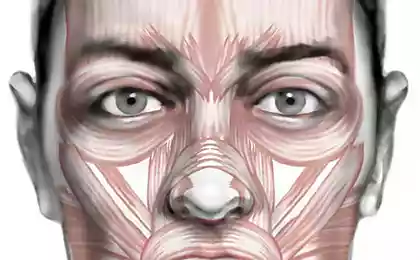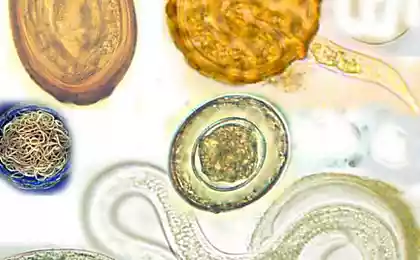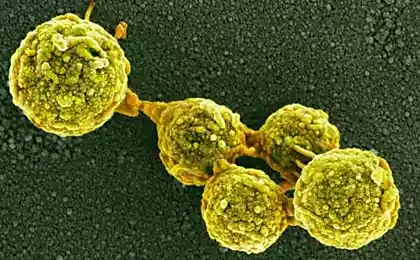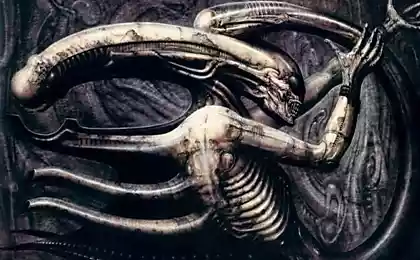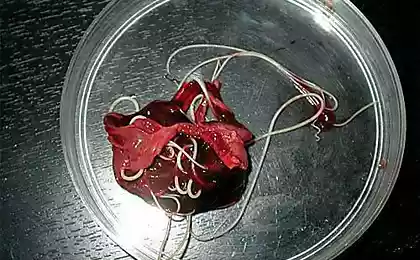1649
The parasites, which can cause irreparable harm to any body
Sacculina
This barnacle crustacean parasite on the crab. It literally grows through all the host body, draining it of nutritious juices. Crab gradually weakens and even lose the ability to regenerate. When it's time for the parasite to multiply, it takes in blood crab special chemicals that cause the female crabs are beginning to take care of the eggs of parasites, as their own. Struck by a parasite crab male mating refuses, and instead under the influence of chemical intoxication takes care of the eggs of the parasite as well as the female.

Cordyceps sided
This tropical parasitic fungus on ants. He is also renowned for being able to control the behavior of the host. When the fungus comes time to breed, it takes an ant chemical team, and he dutifully taken to the upper leaves of the plants and keeps stiffness, allowing the fungus completely grow through his body, a hat to reveal and release spores into the air.

Anisakids
Man risks of contracting these worms by eating poorly treated lesions of marine fish, shrimp, squid or octopus. Anizakidozom first infection was recorded in 1955 in the Netherlands, and has been a source of salted herring.
If razdelyvaya fish you see in its muscle tissue to eggs or milk "some spiral" - a delicacy ruthlessly discard or freeze fish at -20 degrees and hold in this state for at least two weeks. In this processing, microscopic worms and the larvae will die. After that you can safely eat the fish - the truth, the knowledge that she is "wormy" little appetite causes.
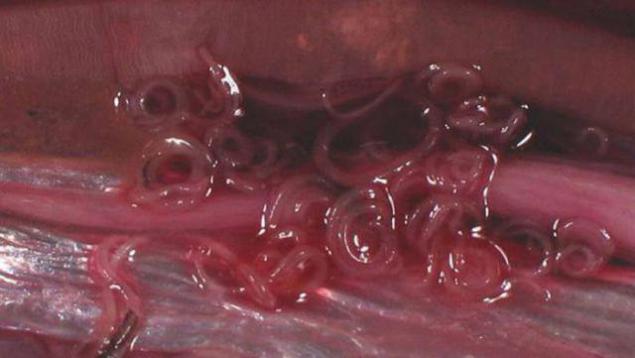
Wolbachia
These bacteria are intracellular parasites of many insects and worms. Multiplying in the body of the host, the bacteria manage to "attach" to his own genome. For example, the genome of certain flies, Drosophila contains also an almost complete copy of the genome of Wolbachia.
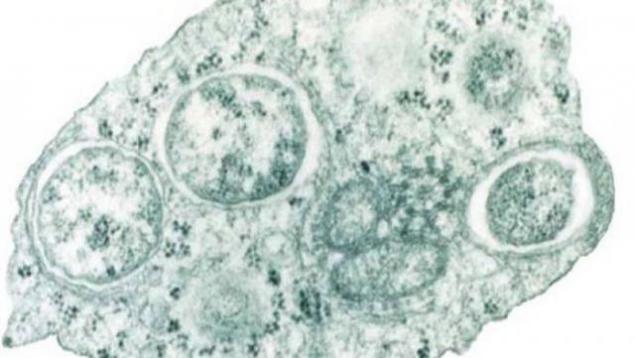
Sand Flea
Sand fleas - a very dangerous parasite that infects animals, rodents, monkeys and humans. Its huge spread is a real problem for countries such as Nigeria, Todago and even Brazil. In disadvantaged areas the number of people suffering from this parasite, can reach 70%. Attacking sand fleas for some reason prefer men. When these parasites infecting human microscopic female flea burrows into the skin under the nails or feet. Total 5-6 days after the introduction of the female abdomen full of eggs, growing to the size of a pea, causing excruciating pain to the owner. When the eggs are mature, the female "shoots" of the environment, and then crawls out of the wound, but more often it dies right in the human body.
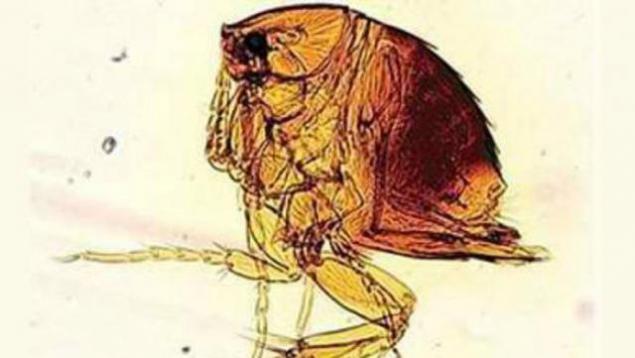
Wasp Hymenoepimecis argyraphaga
Wasp parasitize mainly on spiders. Temporarily paralyzing its prey wasp sticks her chest her egg. Soon spider wakes up and continues his life. Larvae develop slowly sucks the juices out of it, but before pupation in the spider injects a special chemical substance under the influence of which he constructs instead of the usual web special cocoon where the larva and makes the transformation into an adult wasp.

Wandel Candiru
In fact, this small translucent fish parasite in the gills of other fish living in rivers of the Amazon. But in the search for the victim, Candiru guided by the smell of ammonia, which is found in water, passed through the gills. This makes it highly dangerous to humans. If a person is in the water, the sensing chemical signal Candiru lightning introduced into the anus or urethra in a man, sometimes even reaching the bladder. Once inside the body, Candiru inevitably die, but the injury that she can apply, just terrible, and remove her dead body, covered with tenacious thorns can only good surgeon.
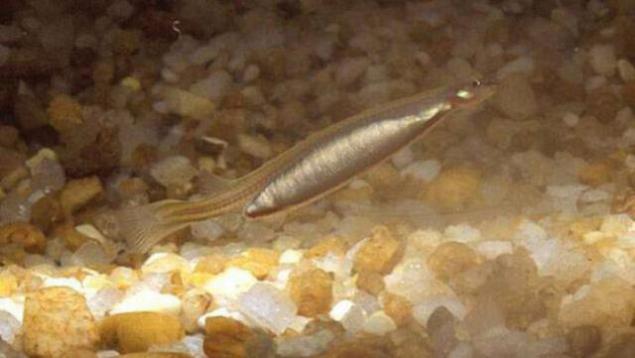
Trichomonas
Trichomonas - a single-celled microorganism flagellate. Some species of Trichomonas perfectly safe, but there are real killers. In birds, these parasites can cause severe inflammation of the mouth and throat, with the result that the bird can not swallow, and eventually die.
Another type of trichomonas (Trichomonas vaginalis) parasite in the urogenital organs and causes severe disease trichomoniasis, which today is the most common disease in the world of the urogenital tract. Medical statistics show that this disease affects almost every tenth inhabitant of the planet.
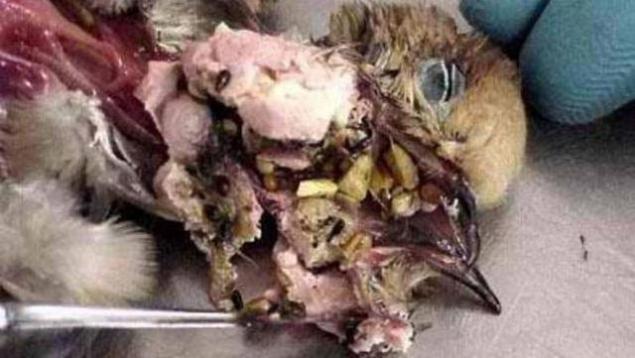
Leishmania
This is a whole cereal protozoa that cause severe disease called leishmaniasis. For example, leishmaniasis of the skin, which is manifested in the form of painful abscesses cause leishmania, parasites first in mosquitoes and flies, and then to warm-blooded animals, including humans. First, the parasites multiply in so gut blood-sucking insects that it completely blocked. Biting human, insect first burps lump parasites into the wound, and then sucks blood. Leishmaniasis is strongly prevalent in tropical countries, and every year in the world there are nearly two million new cases.

Woodlouse devouring language (Cymothoa exigua)
Fortunately for the man this crustacean is completely safe. Woodlouse attached to the language of fish and first sucks blood out of it. When the language is dying fish, a well-established parasite itself starts to perform the role of a prosthetic language, eating with the blood and mucus of fish, but it is not causing much damage.

Trypanosomes
Rhode very dangerous single-celled organisms, parasitic insects and warm-blooded animals. For triatominae transmit tipanosom Trypanosoma cruzi, which causes Chagas disease in humans. The disease affects the entire body and quickly lead to death.

Toxoplasma
The simplest organisms that cause serious illness - toxoplasmosis. The main owners of the parasite - cats, humans and other warm-blooded act as intermediate hosts. Most toxoplasmosis can occur very easily, masquerading as the common cold. But the disease can decrease immunity madness, convulsions, paralysis and other disorders of the nervous system. Toxoplasmosis is especially dangerous for pregnant women, as it results in the death of the child before birth.

Meat fly Cochliomyia hominivorax
The females of the flies, dwelling in America quietly eggs attached to the body of warm-blooded animals. Hatched larvae are introduced under the skin, gnawing in the body of the victim's entire hole. Especially dangerous are those kinds of flies, which lay their eggs in the eyes and nose. In this case, the larvae devour the flesh of the host, can cause blindness and even reach the brain. There are cases when nasopharyngeal person affected by this parasite, doctors removed more than 150 larvae.
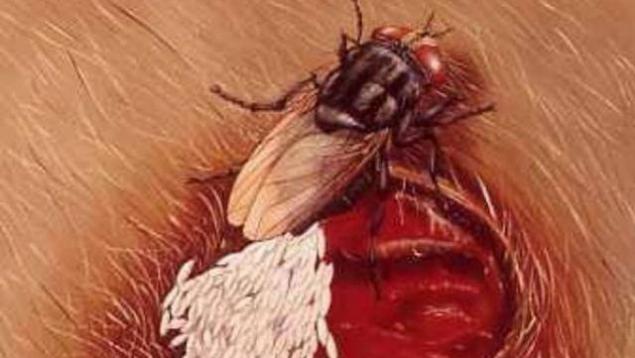
Hair-
It is an ancient water worm whose larvae feed on several species of insects - dragonflies, mayflies, ground beetles, etc. Adult worms pierce the host's body and returned to the pond, where they are breeding.
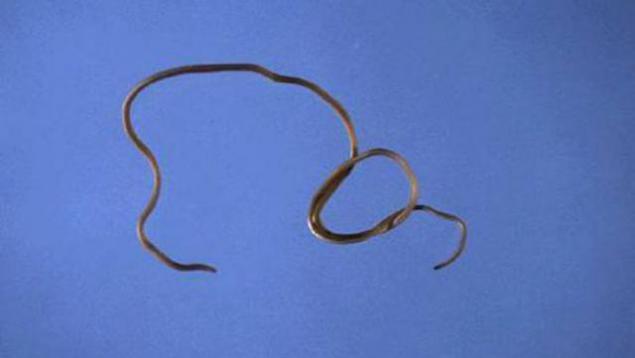
Filaria
In humans parasitize almost 10 different species of filarial. These worms are extremely thin (diameter less than 0, 3 mm) can dostirat almost half a meter in length. Distributors filarial are blood-sucking insects. In humans, the worms can live almost anywhere. When they block the lymphatic system, is developing elephantiasis, and if in the eyes of the flock, the person may become blind.
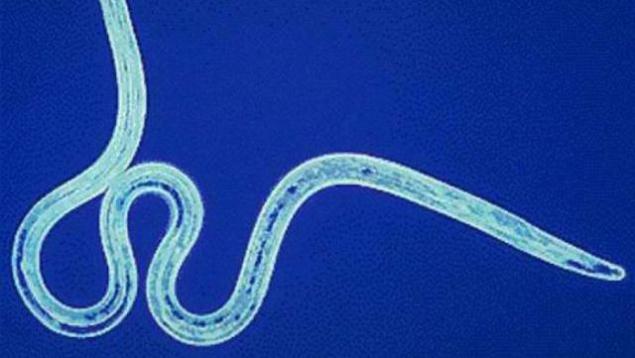
Loa loa
Thin round worm Loa loa is a filaria and quite common in West and Central Africa. Spread the parasite horseflies and other blood-sucking insects. Adult worms live under the skin. Females live larvae hatch immediately, which accumulate in the lungs and peripheric blood vessels, causing a variety of tumors and inflammatory responses. The worms are constantly migrate through the body, and if they get into the eyes, it can cause blindness.
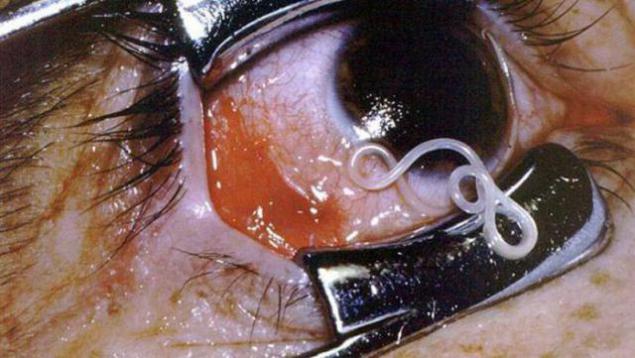
Clostridium perfringens
The bacterium Clostridium perfringens can cause severe food poisoning, as well as being the cause of the rapidly developing gas gangrene in which the affected tissue by bacteria literally dissolve, releasing bubbles of fetid gas.
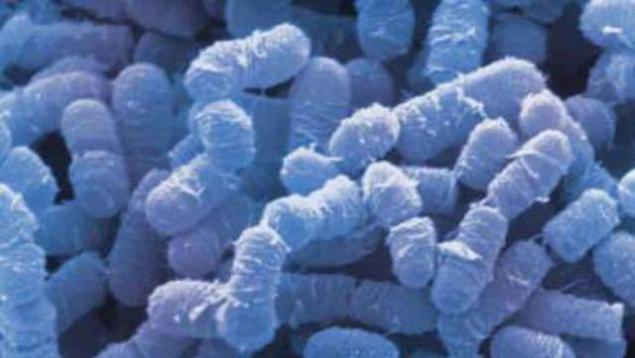
Schistosoma
First, the worm larvae develop in freshwater mussels, and then they go into the water and attack mammals, is implanted under the skin. Schistosoma spread throughout the body and are especially dangerous when accumulated in the bladder and sexual organs. Schistosomiasis runs hard, has a lot of diverse symptoms and causes great suffering.
The parasite is common in Africa, China, the Philippines and Indonesia.

River blindness
River blindness, or onchocerciasis cause filaria Onchocerca volvulus. The carrier of these parasites are lice Simulium damnosum, common along the rivers of West and Central Africa. Worms of this type and their larvae are most often hit the eyes, which leads to complete loss of vision.
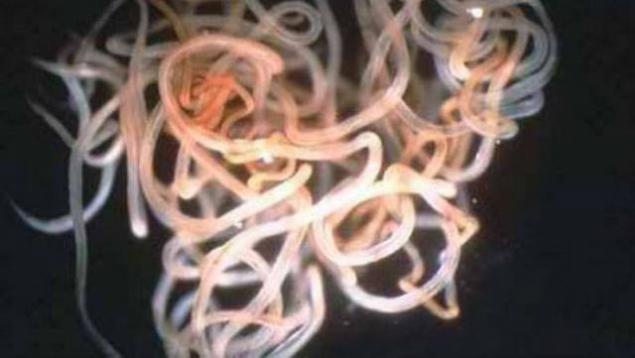
Meningococcus
The bacteria Neisseria meningitidis parasitize nasopharynx many people. Unfortunately, they can cause not only a bad cold, and inflammation of the meninges - meningitis.

Tsetse
By itself, the African tsetse fly is a blood-sucking parasite time. But she often bite infects its prey far more dangerous parasite - the kind tipanosom that cause deadly sleeping sickness.
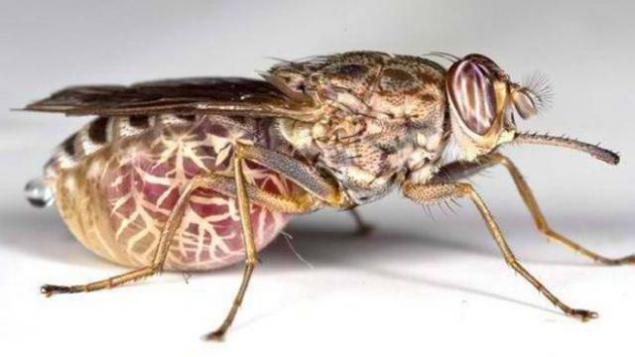
Guinea worm
The worm is distributed in Africa, India and the Arabian Peninsula. Microscopic larvae live in fresh water, and when it comes time to attack animals and humans, is implanted under the skin. Adult worms can be up to 2 mm in thickness and 1 m in length. After mating, the male worms die, and the females are moving in the subcutaneous layer, pierce the skin, and when a person is in the water discharged through the hole done by the larvae.
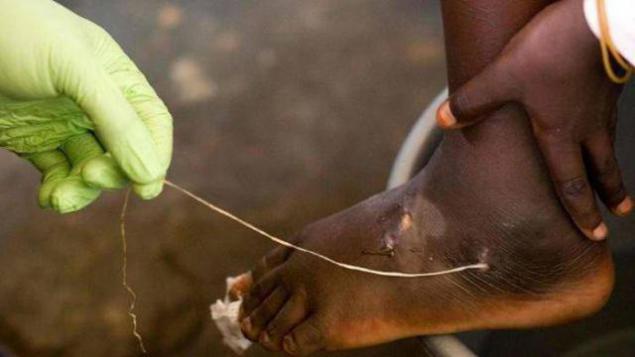
Plasmodium
The parasitic single-celled organisms, some species of which are capable of causing malaria.
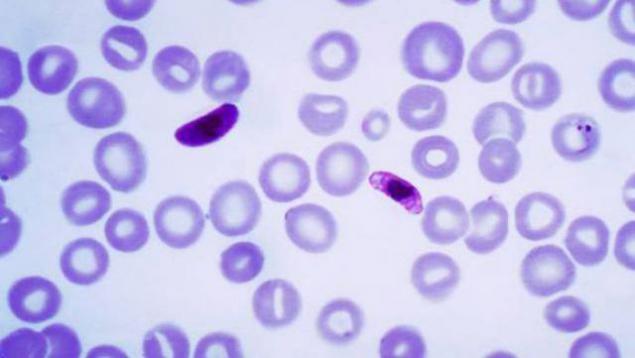
Naegleria fowleri
This amoeba lives in fresh water, the water temperature which is 25-30 degrees. A person infected while swimming. The defeat of these parasites can cause fatal meningitis. Sometimes, when the source of infection are even swimming pools with chlorinated water is bad. Such cases are rare, but each time causing panic as the victims are a swimming pool, spa and hot springs baths.

Leykohloridy paradoxical
Leucochloridium paradoxum - flat worm, a parasite on snails and birds. Snails are the intermediate hosts of the worm. Developing larva grows through the body of a snail, and when one of its appendages (called sporocysts) reaches snail tentacles, it is modified in such a way that it becomes very similar to the green caterpillars that like birds. To make your masquerade even more convincing, the larva constantly twitch outgrowth, mimicking the motion of a caterpillar. All of this is conceived to attract the attention of birds and make it peck "caterpillar." In the body of an infected bird the worm grows into adult forms and lays eggs, which, together with bird droppings fall to the ground, and the development cycle is repeated. Special "paradoxical" this parasite is that snail tentacles deprived, as a rule, does not die, and grow a new one. Then the larva, which is in her body forms a new sporocyst again lures birds.
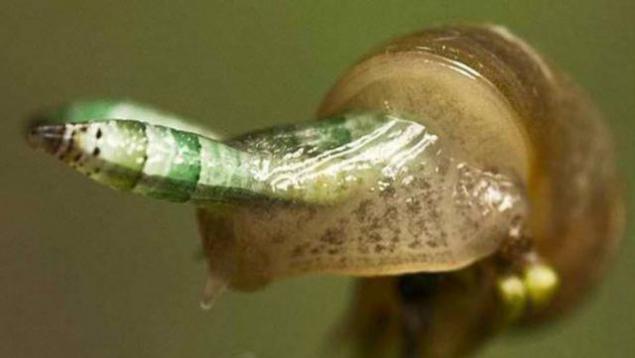
From
This barnacle crustacean parasite on the crab. It literally grows through all the host body, draining it of nutritious juices. Crab gradually weakens and even lose the ability to regenerate. When it's time for the parasite to multiply, it takes in blood crab special chemicals that cause the female crabs are beginning to take care of the eggs of parasites, as their own. Struck by a parasite crab male mating refuses, and instead under the influence of chemical intoxication takes care of the eggs of the parasite as well as the female.

Cordyceps sided
This tropical parasitic fungus on ants. He is also renowned for being able to control the behavior of the host. When the fungus comes time to breed, it takes an ant chemical team, and he dutifully taken to the upper leaves of the plants and keeps stiffness, allowing the fungus completely grow through his body, a hat to reveal and release spores into the air.

Anisakids
Man risks of contracting these worms by eating poorly treated lesions of marine fish, shrimp, squid or octopus. Anizakidozom first infection was recorded in 1955 in the Netherlands, and has been a source of salted herring.
If razdelyvaya fish you see in its muscle tissue to eggs or milk "some spiral" - a delicacy ruthlessly discard or freeze fish at -20 degrees and hold in this state for at least two weeks. In this processing, microscopic worms and the larvae will die. After that you can safely eat the fish - the truth, the knowledge that she is "wormy" little appetite causes.

Wolbachia
These bacteria are intracellular parasites of many insects and worms. Multiplying in the body of the host, the bacteria manage to "attach" to his own genome. For example, the genome of certain flies, Drosophila contains also an almost complete copy of the genome of Wolbachia.

Sand Flea
Sand fleas - a very dangerous parasite that infects animals, rodents, monkeys and humans. Its huge spread is a real problem for countries such as Nigeria, Todago and even Brazil. In disadvantaged areas the number of people suffering from this parasite, can reach 70%. Attacking sand fleas for some reason prefer men. When these parasites infecting human microscopic female flea burrows into the skin under the nails or feet. Total 5-6 days after the introduction of the female abdomen full of eggs, growing to the size of a pea, causing excruciating pain to the owner. When the eggs are mature, the female "shoots" of the environment, and then crawls out of the wound, but more often it dies right in the human body.

Wasp Hymenoepimecis argyraphaga
Wasp parasitize mainly on spiders. Temporarily paralyzing its prey wasp sticks her chest her egg. Soon spider wakes up and continues his life. Larvae develop slowly sucks the juices out of it, but before pupation in the spider injects a special chemical substance under the influence of which he constructs instead of the usual web special cocoon where the larva and makes the transformation into an adult wasp.

Wandel Candiru
In fact, this small translucent fish parasite in the gills of other fish living in rivers of the Amazon. But in the search for the victim, Candiru guided by the smell of ammonia, which is found in water, passed through the gills. This makes it highly dangerous to humans. If a person is in the water, the sensing chemical signal Candiru lightning introduced into the anus or urethra in a man, sometimes even reaching the bladder. Once inside the body, Candiru inevitably die, but the injury that she can apply, just terrible, and remove her dead body, covered with tenacious thorns can only good surgeon.

Trichomonas
Trichomonas - a single-celled microorganism flagellate. Some species of Trichomonas perfectly safe, but there are real killers. In birds, these parasites can cause severe inflammation of the mouth and throat, with the result that the bird can not swallow, and eventually die.
Another type of trichomonas (Trichomonas vaginalis) parasite in the urogenital organs and causes severe disease trichomoniasis, which today is the most common disease in the world of the urogenital tract. Medical statistics show that this disease affects almost every tenth inhabitant of the planet.

Leishmania
This is a whole cereal protozoa that cause severe disease called leishmaniasis. For example, leishmaniasis of the skin, which is manifested in the form of painful abscesses cause leishmania, parasites first in mosquitoes and flies, and then to warm-blooded animals, including humans. First, the parasites multiply in so gut blood-sucking insects that it completely blocked. Biting human, insect first burps lump parasites into the wound, and then sucks blood. Leishmaniasis is strongly prevalent in tropical countries, and every year in the world there are nearly two million new cases.

Woodlouse devouring language (Cymothoa exigua)
Fortunately for the man this crustacean is completely safe. Woodlouse attached to the language of fish and first sucks blood out of it. When the language is dying fish, a well-established parasite itself starts to perform the role of a prosthetic language, eating with the blood and mucus of fish, but it is not causing much damage.

Trypanosomes
Rhode very dangerous single-celled organisms, parasitic insects and warm-blooded animals. For triatominae transmit tipanosom Trypanosoma cruzi, which causes Chagas disease in humans. The disease affects the entire body and quickly lead to death.

Toxoplasma
The simplest organisms that cause serious illness - toxoplasmosis. The main owners of the parasite - cats, humans and other warm-blooded act as intermediate hosts. Most toxoplasmosis can occur very easily, masquerading as the common cold. But the disease can decrease immunity madness, convulsions, paralysis and other disorders of the nervous system. Toxoplasmosis is especially dangerous for pregnant women, as it results in the death of the child before birth.

Meat fly Cochliomyia hominivorax
The females of the flies, dwelling in America quietly eggs attached to the body of warm-blooded animals. Hatched larvae are introduced under the skin, gnawing in the body of the victim's entire hole. Especially dangerous are those kinds of flies, which lay their eggs in the eyes and nose. In this case, the larvae devour the flesh of the host, can cause blindness and even reach the brain. There are cases when nasopharyngeal person affected by this parasite, doctors removed more than 150 larvae.

Hair-
It is an ancient water worm whose larvae feed on several species of insects - dragonflies, mayflies, ground beetles, etc. Adult worms pierce the host's body and returned to the pond, where they are breeding.

Filaria
In humans parasitize almost 10 different species of filarial. These worms are extremely thin (diameter less than 0, 3 mm) can dostirat almost half a meter in length. Distributors filarial are blood-sucking insects. In humans, the worms can live almost anywhere. When they block the lymphatic system, is developing elephantiasis, and if in the eyes of the flock, the person may become blind.

Loa loa
Thin round worm Loa loa is a filaria and quite common in West and Central Africa. Spread the parasite horseflies and other blood-sucking insects. Adult worms live under the skin. Females live larvae hatch immediately, which accumulate in the lungs and peripheric blood vessels, causing a variety of tumors and inflammatory responses. The worms are constantly migrate through the body, and if they get into the eyes, it can cause blindness.

Clostridium perfringens
The bacterium Clostridium perfringens can cause severe food poisoning, as well as being the cause of the rapidly developing gas gangrene in which the affected tissue by bacteria literally dissolve, releasing bubbles of fetid gas.

Schistosoma
First, the worm larvae develop in freshwater mussels, and then they go into the water and attack mammals, is implanted under the skin. Schistosoma spread throughout the body and are especially dangerous when accumulated in the bladder and sexual organs. Schistosomiasis runs hard, has a lot of diverse symptoms and causes great suffering.
The parasite is common in Africa, China, the Philippines and Indonesia.

River blindness
River blindness, or onchocerciasis cause filaria Onchocerca volvulus. The carrier of these parasites are lice Simulium damnosum, common along the rivers of West and Central Africa. Worms of this type and their larvae are most often hit the eyes, which leads to complete loss of vision.

Meningococcus
The bacteria Neisseria meningitidis parasitize nasopharynx many people. Unfortunately, they can cause not only a bad cold, and inflammation of the meninges - meningitis.

Tsetse
By itself, the African tsetse fly is a blood-sucking parasite time. But she often bite infects its prey far more dangerous parasite - the kind tipanosom that cause deadly sleeping sickness.

Guinea worm
The worm is distributed in Africa, India and the Arabian Peninsula. Microscopic larvae live in fresh water, and when it comes time to attack animals and humans, is implanted under the skin. Adult worms can be up to 2 mm in thickness and 1 m in length. After mating, the male worms die, and the females are moving in the subcutaneous layer, pierce the skin, and when a person is in the water discharged through the hole done by the larvae.

Plasmodium
The parasitic single-celled organisms, some species of which are capable of causing malaria.

Naegleria fowleri
This amoeba lives in fresh water, the water temperature which is 25-30 degrees. A person infected while swimming. The defeat of these parasites can cause fatal meningitis. Sometimes, when the source of infection are even swimming pools with chlorinated water is bad. Such cases are rare, but each time causing panic as the victims are a swimming pool, spa and hot springs baths.

Leykohloridy paradoxical
Leucochloridium paradoxum - flat worm, a parasite on snails and birds. Snails are the intermediate hosts of the worm. Developing larva grows through the body of a snail, and when one of its appendages (called sporocysts) reaches snail tentacles, it is modified in such a way that it becomes very similar to the green caterpillars that like birds. To make your masquerade even more convincing, the larva constantly twitch outgrowth, mimicking the motion of a caterpillar. All of this is conceived to attract the attention of birds and make it peck "caterpillar." In the body of an infected bird the worm grows into adult forms and lays eggs, which, together with bird droppings fall to the ground, and the development cycle is repeated. Special "paradoxical" this parasite is that snail tentacles deprived, as a rule, does not die, and grow a new one. Then the larva, which is in her body forms a new sporocyst again lures birds.

From
